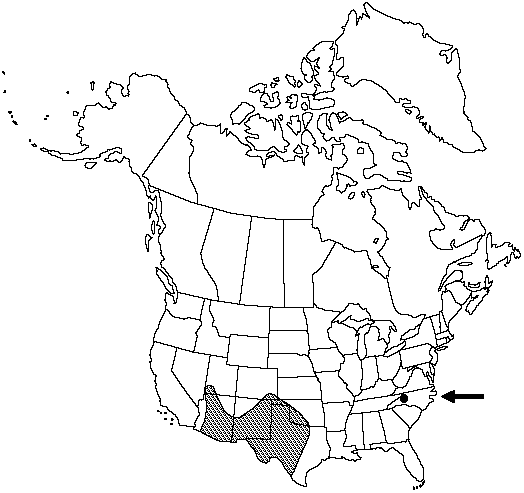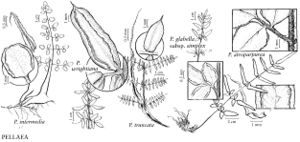Difference between revisions of "Pellaea wrightiana"
Sp. Fil. 2: 142. 1858.
FNA>Volume Importer |
FNA>Volume Importer |
||
| Line 50: | Line 50: | ||
|publication year=1858 | |publication year=1858 | ||
|special status= | |special status= | ||
| − | |source xml=https://jpend@bitbucket.org/aafc-mbb/fna-data-curation.git/src/ | + | |source xml=https://jpend@bitbucket.org/aafc-mbb/fna-data-curation.git/src/f50eec43f223ca0e34566be0b046453a0960e173/coarse_grained_fna_xml/V2/V2_480.xml |
|genus=Pellaea | |genus=Pellaea | ||
|species=Pellaea wrightiana | |species=Pellaea wrightiana | ||
Revision as of 20:50, 16 December 2019
Stems compact, ascending, stout, 5–10 mm diam.; scales bicolored, linear-subulate, 0.1–0.3 mm wide, centers black, thick, margins brown, thin, erose-dentate. Leaves monomorphic, clustered on stem, 6–40 cm; croziers sparsely villous. Petiole dark brown, lustrous, flattened or slightly grooved adaxially, without prominent articulation lines. Blade linear-oblong, 2-pinnate proximally, 1.5–5 cm wide; rachis brown throughout, straight, shallowly grooved adaxially, usually glabrous. Pinnae perpendicular to rachis or slightly ascending, not decurrent on rachis, usually with 3–9 ultimate segments; costae straight, 2–20 mm, usually shorter than ultimate segments. Ultimate segments narrowly oblong, 5–20 mm, leathery, glabrous; margins recurved on fertile segments, usually covering less than 1/2 abaxial surface, borders whitish, crenulate; apex mucronate. Veins of ultimate segments obscure. Sporangia long-stalked, containing 64 spores, intermixed with sparse farina-producing glands. 2n = 116.
Phenology: Sporulating summer–fall.
Habitat: Cliffs and rocky slopes, on a variety of acidic to mildly basic substrates
Elevation: 300–2900 m
Distribution

Ariz., Colo., N.Mex., N.C., Okla., Tex., Utah, n Mexico.
Discussion
W. H. Wagner Jr. (1965) suggested that Pellaea wrightiana was a fertile allotetraploid hybrid between P. truncata (as P. longimucronata) and P. ternifolia. This hypothesis has been confirmed by isozyme analyses (M. D. Windham 1988). Pellaea wrightiana is therefore treated as a distinct species rather than a variety of P. ternifolia. This tetraploid species hybridizes with P. truncata and P. ternifolia subsp. arizonica to produce sterile triploids and tetraploids with intermediate morphology and malformed spores. Pellaea wrightiana has also hybridized with P. atropurpurea to form a rare apogamous pentaploid known only from western Oklahoma.
Selected References
None.
